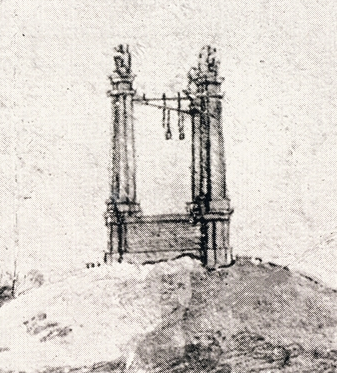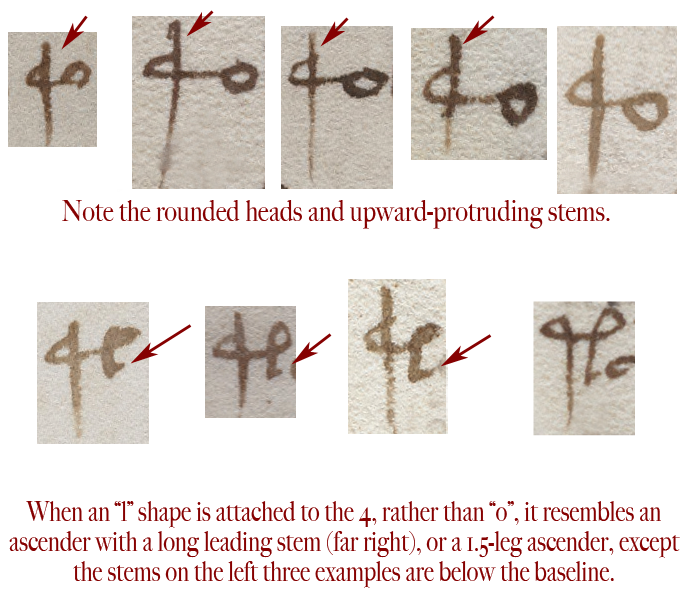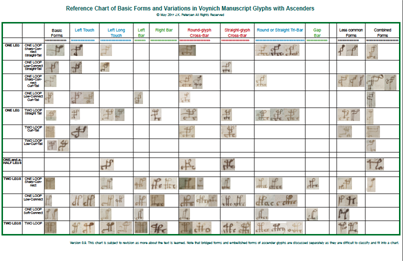VMS characters with ascenders have some interesting properties beyond their frequent appearance at the beginnings of paragraphs. Unfortunately, the seemingly simple task of selecting the most representative shapes and slotting them into a grid took far longer than I expected and this blog languished in “draft” status for several years. I did manage to post a preliminary assessment of whether some of the glyphs might be pilcrows, but did not go into depth about the glyphs themselves because I wanted to discuss that in a separate blog as follows…
Interpreting the Text
My perception of VMS glyphs differs substantially from one of the more popular transcripts created by Takeshi Takahashi. So much so, that I ended up creating my own rather than using any of the ones that were extant. I wanted to correct a number of errors, add the labels, and allow for the possibility that certain variations might be meaningful rather than the result of scribal variations. What follows is not just a collection of glyphs with differing shapes—it’s the result of a long process of trying to statistically differentiate variations that are meaningful from those that are not.
The “Gallows” Characters
 As mentioned in previous blogs, most of the VMS glyphs can be traced to Latin characters and abbreviations, with a few that are derived from Greek, but there are some tall glyphs that are sufficiently different to modern eyes that they have been dubbed “gallows characters”. Not everyone is happy about the “gallows” moniker, so I’ll mostly refer to them as VMS glyphs with ascenders. Here is a sample of some common shapes. Note that some have one loop and some have two:
As mentioned in previous blogs, most of the VMS glyphs can be traced to Latin characters and abbreviations, with a few that are derived from Greek, but there are some tall glyphs that are sufficiently different to modern eyes that they have been dubbed “gallows characters”. Not everyone is happy about the “gallows” moniker, so I’ll mostly refer to them as VMS glyphs with ascenders. Here is a sample of some common shapes. Note that some have one loop and some have two:
 The VMS ascenders are not entirely alien. If they are ligatures (more than one character joined to create a cohesive shape), then the two-legged variety (right) resembles the Latin abbreviation for “-tis” or “Item”. The “P” shape could come from anywhere. A “P” shape is common to many alphabets, including Greek, Latin, Armenian, Cyrillic, and others, but I suspect that a rational design process may account more fully for the VMS “P” than any particular alphabet, an idea that I’ll describe below.
The VMS ascenders are not entirely alien. If they are ligatures (more than one character joined to create a cohesive shape), then the two-legged variety (right) resembles the Latin abbreviation for “-tis” or “Item”. The “P” shape could come from anywhere. A “P” shape is common to many alphabets, including Greek, Latin, Armenian, Cyrillic, and others, but I suspect that a rational design process may account more fully for the VMS “P” than any particular alphabet, an idea that I’ll describe below.
The Takahashi transcription recognizes four basic kinds of ascenders, the single-leg glyph (left), the double-leg glyph (right) and the double-looped version of each. Added to this are “benched” versions of each of the shapes—those that have a crossbar near the base that connects glyphs on either side. These are designated in the transcript with an uppercase “Z” that follows the character for the basic form, which is not a bad way to do it, since it allows for searching both the benched and unbenched varieties, and uses a shape that is easy to remember as the rotated Z somewhat resembles a crossbar.
Others have noticed that the crossbar does not always connect on both sides and have tried to account for this in various revisions of the EVA fonts.
Discerning Intent
I would like to propose that this appealingly simple classification scheme utilized in the Takahashi transcript may be wrong. When you really study them, there’s more to the ascenders than meets the eye and pen variations may, in fact, be meaningful.
Those who are familiar with Hebrew and some of the Malaysian scripts, already understand that subtle differences between characters might change their meaning. The swoop of a tail, the presence of a dot or tick mark that is high, medium or low, or the length of a crossbar, represent different letters or syllables. I think some of these variations may also exist in the VMS characters, but one cannot judge solely on shape, one has to look at the distribution and position of the glyphs, and the way they are written by different scribes.
Before discussing this in depth, I’d like to point out some morphological similarities between the two more distinctive ascenders. Note how the two-legged ascender resembles a one-legged ascender whose drawing was interrupted before the second leg was finished:
If you are skeptical that this may be the basis for the “P” shape, consider examples 5 and 6 below, in which the “interrupted” leg is clearly visible, a glyph that is neither a single- or double-leg, but one that is in between:

In the images that are second and third from the right, note how the second leg does not always reach the baseline or swoop back in a tail. The leg second-right is attached to a c-shape, a combination that occurs less ambiguously in other parts of the manuscript. This suggests the shapes might be ligatures, rather than individual characters and that the 1.5-legged glyph may be a component in its own right.
There’s more to this 1.5-leg idea that might surprise you…
Take a look at these 4o glyphs (EVA-qo) that have a long stem that rises up above the leading c-shape (not all 4o glyphs have a rounded head, some are very sharp, but these are all round). Then look at the shapes below them that are constructed the same way but are followed by an “l” shape rather than “o”.
Did you notice how this “4o” variant on the second line below resembles a 1.5-leg gallows? The main difference is that the shape on the left is a descender rather than an ascender. If it were shifted upwards, it would be interpreted as a 1.5-leg gallows without an additional letter or crossbar, but it superficially resembles 4o because it appears at the beginning of V-words and is mostly below the baseline. The long-stemmed “4” may be distinct from other glyphs identified as EVA-q:
I don’t believe the various theories that there are microscopic encodings in the VMS, based on incredibly tiny variations in shapes—I’ve seen no convincing evidence that this is so. I do however, believe that some of the more overt differences that might be meaningful have been overlooked and might make the text look more repetitive than it actually is.
The Case of the Curly Tail
Something I’ve wondered since I first examined the VMS is whether the curled tails on ascenders and other characters are meaningful. In Latin, a curled tail on the letters “i” or “r” are significant. They indicate abbreviations such as “er/ir/re/re” and sometimes “us/um”. On a “P”, they differentiate between “pro” and “per”.
Some scribes even control the shape of the tail to differentiate between “er” and “ir”. You’ll notice in the self-similarity example above that the far-right glyph has a distinctly curled tail. The one in the picture below is clearly straight. There are some that are slightly ambiguous but most of them can be differentiated as one or the other.
Does the difference matter in the VMS? I suspect it does. Curly tails appear more often on ascenders that are in key positions, such as the beginnings of paragraphs or places where one might expect a capitulum, but it’s difficult to know from position alone whether this is their function. Most of the midline ascenders do not have curled tails. This is not the way “per” and “pro” behave in Latin. They are liberally sprinkled throughout the text, with “per” being a bit more common than “pro”, but not excessively so, so it appears that the VMS glyphs are similar to Latin in shape but not necessarily in function.
Notes About the Chart
What follows is a PDF file with one possible configuration for studying and classifying VMS characters with ascenders, based on variations that may distinguish one from another.
- As far as I can tell, the length of the tail is not significant, except possibly when it touches the baseline on a standalone glyph, or the bottom of the stem on a combination-glyph.
- The shape of the tail (straight or curved) looks like it might be significant.
- There appears to be some consistency in the way the connections are made on one-legged ascenders. The top-left connection might be significant. The bottom right corner, where the tail is attached, is sometimes sharp and sometimes rounded, but this connection doesn’t appear to be significant, as far as I can tell.
- The characters that connect to the crossbars on “benched” characters are quite variable and the variation appears deliberate. The straight benches do not appear to be corrupted c-shapes. They might represent EVA-i, or EVA-r without the tail.
- The combination glyphs appear to be a gallows character combined with lowercase glyphs or two gallows glyphs combined, perhaps as a way to put two together without setting them next to each other. It’s my feeling that combination characters differ from embellished ascenders, but I am not certain yet.
This is a preliminary chart, subject to revision. You can click on the link under the thumbnail to download the PDF file:
(New chart uploaded June 3, 2017, with one error corrected. June 4, 2017, Gap bar moved next to Touch bars.)
J.K. Petersen
© Copyright 2017 J.K. Petersen, All Rights Reserved



